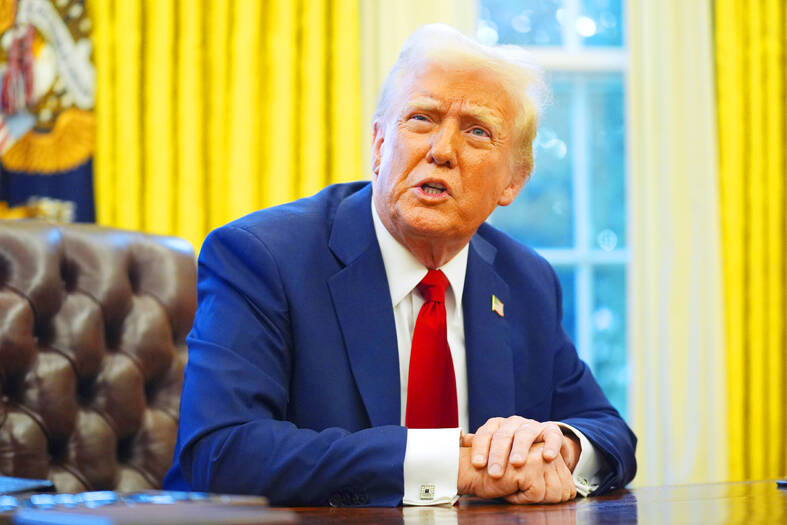US President Donald Trump said his 25 percent tariffs on Canada and Mexico are coming today, but he is still considering whether to include oil from those countries as part of his import taxes.
“We may or may not,” Trump told reporters on Thursday in the Oval Office about tariffing oil from Canada and Mexico. “We’re going to make that determination probably tonight.”
Trump said his decision would be based on whether the price of oil charged by the two trading partners is fair, although the basis of his threatened tariffs pertains to stopping illegal immigration and the smuggling of chemicals used for fentanyl.

Photo: AP
The risk of tariffs on Canadian and Mexican oil could undermine Trump’s repeated pledge to lower overall inflation by reducing energy costs.
Costs associated with tariffs could be passed along to consumers in the form of higher gasoline prices — an issue that Trump placed at the center of his Republican presidential campaign as he vowed to halve energy costs within one year.
The US imported almost 4.6 million barrels of oil daily from Canada in October last year and 563,000 barrels from Mexico, according to the US Energy Information Administration.
US daily production during that month averaged nearly 13.5 million barrels a day.
Matthew Holmes, executive vice president and chief of public policy at the Canadian Chamber of Commerce, said Trump’s tariffs would “tax America first” in the form of higher costs.
“This is a lose-lose,” Holmes said.
“We will keep working with partners to show President Trump and Americans that this doesn’t make life any more affordable. It makes life more expensive and sends our integrated businesses scrambling,” Holmes added.
Trump also said that China would pay tariffs for its exporting of the chemicals used to make fentanyl. He has previously stated a 10 percent tariff that would be on top of other import taxes charged on products from China.
Global crude oil prices were trading at roughly US$73 a barrel on Thursday afternoon. Gasoline prices were averaging US$3.12 a gallon across the US, roughly the same price as a year ago, according to AAA.
Later on Thursday, Trump threatened more tariffs against countries looking at alternatives to the US dollar as a means of global exchange.
The president made the same threat in November last year against the so-called BRICS group, which includes Brazil, Russia, India, China, South Africa, Egypt, Ethiopia, Iran and the United Arab Emirates.
Russian President Vladimir Putin has suggested that sanctions against his country and others mean that nations need to develop a substitute for the US dollar.
“We are going to require a commitment from these seemingly hostile Countries that they will neither create a new BRICS Currency, nor back any other Currency to replace the mighty US Dollar or, they will face 100 percent Tariffs, and should expect to say goodbye to selling into the wonderful US Economy,” Trump posted on social media.

UNCERTAINTY: Innolux activated a stringent supply chain management mechanism, as it did during the COVID-19 pandemic, to ensure optimal inventory levels for customers Flat-panel display makers AUO Corp (友達) and Innolux Corp (群創) yesterday said that about 12 to 20 percent of their display business is at risk of potential US tariffs and that they would relocate production or shipment destinations to mitigate the levies’ effects. US tariffs would have a direct impact of US$200 million on AUO’s revenue, company chairman Paul Peng (彭雙浪) told reporters on the sidelines of the Touch Taiwan trade show in Taipei yesterday. That would make up about 12 percent of the company’s overall revenue. To cope with the tariff uncertainty, AUO plans to allocate its production to manufacturing facilities in

TAKING STOCK: A Taiwanese cookware firm in Vietnam urged customers to assess inventory or place orders early so shipments can reach the US while tariffs are paused Taiwanese businesses in Vietnam are exploring alternatives after the White House imposed a 46 percent import duty on Vietnamese goods, following US President Donald Trump’s announcement of “reciprocal” tariffs on the US’ trading partners. Lo Shih-liang (羅世良), chairman of Brico Industry Co (裕茂工業), a Taiwanese company that manufactures cast iron cookware and stove components in Vietnam, said that more than 40 percent of his business was tied to the US market, describing the constant US policy shifts as an emotional roller coaster. “I work during the day and stay up all night watching the news. I’ve been following US news until 3am

Taiwan will prioritize the development of silicon photonics by taking advantage of its strength in the semiconductor industry to build another shield to protect the local economy, National Development Council (NDC) Minister Paul Liu (劉鏡清) said yesterday. Speaking at a meeting of the legislature’s Economics Committee, Liu said Taiwan already has the artificial intelligence (AI) industry as a shield, after the semiconductor industry, to safeguard the country, and is looking at new unique fields to build more economic shields. While Taiwan will further strengthen its existing shields, over the longer term, the country is determined to focus on such potential segments as

COLLABORATION: Given Taiwan’s key position in global supply chains, the US firm is discussing strategies with local partners and clients to deal with global uncertainties Advanced Micro Devices Inc (AMD) yesterday said it is meeting with local ecosystem partners, including Taiwan Semiconductor Manufacturing Co (TSMC, 台積電), to discuss strategies, including long-term manufacturing, to navigate uncertainties such as US tariffs, as Taiwan occupies an important position in global supply chains. AMD chief executive officer Lisa Su (蘇姿丰) told reporters that Taiwan is an important part of the chip designer’s ecosystem and she is discussing with partners and customers in Taiwan to forge strong collaborations on different areas during this critical period. AMD has just become the first artificial-intelligence (AI) server chip customer of TSMC to utilize its advanced